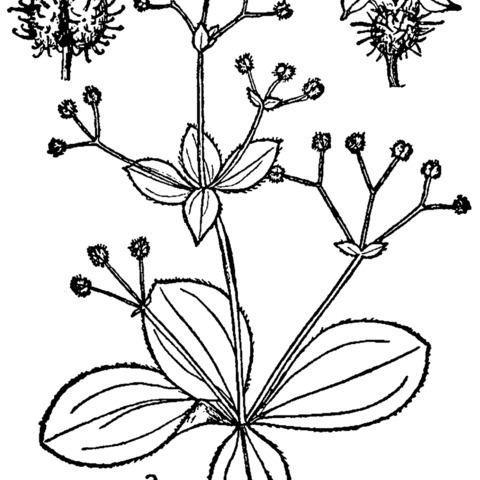Herbs, perennial, erect, 5-25 cm tall, emerging from filiform rhizomes. Stems mostly unbranched, 4-angled, glabrous to sparsely hispidulous. Leaves in whorls of 4, sessile or subsessile; blade drying blackish brown and papery, broadly elliptic, ovate, or suborbicular, 10-25 × 6-17 mm, glabrous to hispidulous at least on veins, otherwise adaxially smooth, abaxially not glandular-striate, base cuneate to obtuse, margins antrorsely ciliolate or hispidulous, apex ± rounded and usually mucronate; principal veins 3, palmate. Inflorescences small, thyrsoid, cymes terminal and in axils of uppermost leaves, 2-6 cm, few to several flowered, lax; peduncles glabrous, smooth; bracts leaflike or ligulate to narrowly elliptic, 0.5-4 mm; pedicels 1-5 mm. Ovary subglobose, ca. 1 mm, densely pubescent with spreading uncinate trichomes. Corolla white or greenish yellow, rotate, 2.5-3(-4) mm in diam., glabrous, lobed for 3/4 or more; lobes 4, elliptic-lanceolate or ovate-triangular, acute. Mericarps ovoid, 1.5-2 mm, with dense uncinate trichomes 0.8-1 mm, on pedicels usually elongating to 15 mm. Fl. and fr. Jul-Sep.
More
Stems scattered, erect, 1–2 dm, glabrous; lvs in 2–4(5) whorls of 4, antrorsely scabro-ciliate and commonly with scattered similar hairs at least on the upper surface, thin,evidently trinerved, broadly obovate to broadly ovate-elliptic, 1–3 cm, half or two-thirds as wide, mucronate at the blunt apex, mostly concavely narrowed to the cuneate base; peduncles 1–2 from the uppermost whorl of lvs, rather elongate, 2–3(–6)-fld; fr 1.5 mm, uncinate-bristly; 2n=22, 44. Mossy woods; n. N. Engl. and n. N.Y. to se. Can.; ne. side of Lake Superior; near the Pacific coast from Korea to Wash. July.

